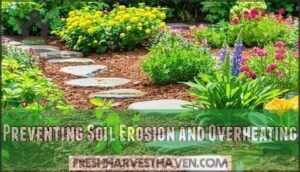This site is supported by our readers. We may earn a commission, at no cost to you, if you purchase through links.
 You’re taking steps to protect your summer garden from heat, which is great.
You’re taking steps to protect your summer garden from heat, which is great.
To start, you can install shade cloth or use umbrellas to provide shade for vulnerable plants.
Watering them thoroughly in the morning also helps.
Adding mulch retains moisture and keeps soil cool.
Choosing heat-tolerant plant varieties is another smart move.
By taking these steps, you’re on your way to safeguarding your garden.
Now, let’s explore more strategies for effectively protecting your summer garden from heat, and uncover some surprising tips to keep your plants thriving.
Table Of Contents
- Key Takeaways
- Heat Wave Impact Explained
- Choosing Heat Resistant Plants
- Mulching and Soil Management
- Effective Watering Techniques
- Protecting Plants From Extreme Heat
- Frequently Asked Questions (FAQs)
- How do I protect my garden from extreme heat?
- What temperature is too hot for garden plants?
- How to protect your garden from extreme heat?
- How to keep plants alive in 100 degree weather?
- What temperature is too hot for a garden?
- How do container gardens differ in heat protection?
- When to harvest during extreme heat waves?
- Can companion planting reduce heat stress?
- Are automated irrigation systems worth installing?
- Do heat-stressed plants recover completely afterward?
- Conclusion
Key Takeaways
- You’ll want to protect your summer garden from heat by using shade cloth, umbrellas, or other shade structures to prevent heat stress and promote healthy growth.
- It’s crucial to water your plants wisely, using deep watering techniques and adjusting your watering schedule according to the weather, to keep them hydrated and thriving.
- You can also use mulch to retain moisture, regulate soil temperature, and prevent weeds from growing, which will help your plants survive the hot weather.
- By choosing heat-tolerant plant varieties, using drought-resistant plants, and monitoring your plants’ health, you’ll be able to safeguard your summer garden from extreme heat and ensure it stays healthy and thriving.
Heat Wave Impact Explained
You’re probably aware that heat waves can be devastating to your summer garden, causing plants to wilt and struggle to survive.
Heat waves can devastate summer gardens, causing plants to wilt and struggle to survive.
As you prepare to protect your garden from the heat, this is vital to understand the impact of heat waves on your plants and how to mitigate the damage.
Rising Global Temperatures
A rising thermometer is the new normal—thanks to a global Climate Shift, Earth has warmed over 1°C since 1880.
Heat Waves hit harder every summer and don’t play favorites; these extremes are now three times more common since the early ‘80s.
You might notice your summer garden care routines fail to deliver—Global Warming is the culprit.
It’s time to rethink Temperature Control. Consider drip irrigation or other heat protection methods to keep your heat tolerant plants thriving and master heat wave gardening like a pro.
Understanding the global temperature rise is essential for adapting gardening strategies to the changing climate.
Consequences for Gardens and Plants
When the summer sun’s relentless, your garden can feel like it’s walking barefoot across hot pavement.
Summer gardens can feel like they’re walking on hot coals without proper heat protection
High temperatures lead to heat stress, pushing your plants to their limits.
Here’s how heat waves bring trouble:
- Upward-curled, wilted leaves are classic signs of Plant Stress and Heat Damage
- Production plummets: fewer flowers, fewer fruits, more headaches
- Young seedlings and tender shoots show Garden Vulnerability quickly
- Soil Degradation and dehydration block water even when watering seems enough
- Temperatures above 85°F disrupt metabolism, risking crop failure and lasting damage
Summer garden protection means spotting these challenges early!
Climate Zones and Plant Adaptability
As you garden, consider regional gardening and climate classification.
Heat tolerance varies by plant, with some acclimating better to heatwaves. Understanding climate zone maps is essential for making informed decisions.
| Plant Type | Heat Tolerance | Geographic Variations |
|---|---|---|
| Vegetables | Medium |
This approach helps in creating a well-informed gardening plan, taking into account the climate zone and its impact on plant selection.
Factors Influencing Heat Stress
You’re addressing heat stress in your garden. Several factors influence it, including:
- Plant hardiness
- Soil temperature
- Heat duration
These factors affect heat tolerance, leading to water loss and heat stress. Managing them is key to heat protection and resilience.
Effective use of drought tolerant plants can also help mitigate heat stress in gardens.
Choosing Heat Resistant Plants
The right plant choices can make or break your garden’s heat survival odds.
While some plants wilt at the first sign of high temperatures, others actually thrive when the mercury rises, giving you a green oasis even during brutal summer conditions.
Native Plants and Local Climate
Tough heat doesn’t have to spell disaster for your garden.
Trust your local ecosystem—native plants are your A-team for heatwave gardening.
They’re already tuned to your soil, rainfall, and wild temperature swings.
You’ll notice less watering, fewer pests, and plants that shrug off the heat like seasoned desert-adapted pros.
Regional biodiversity comes alive when you champion native species.
It’s like giving your backyard a superhero cape—nature’s own climate adaptation at work.
By choosing plants with native plant benefits, you can create a more resilient garden with the help of native plant species.
| Feeling Stuck? | Native Plants Offer |
|---|---|
| Sunburned leaves | Lasting shade |
| Endless watering | Deep-rooted relief |
| Pest invasions | Natural defense |
| Soil struggles | Local fit |
| Wilting hopes | Fresh resilience |
Drought Resistant Plants and Varieties
You’ll love these 5 drought resistant plants:
- Succulents
- Legume species
- Buffalo grass
- Mediterranean herbs
- Cacti.
They offer heat tolerance, water efficiency, and soil conservation, making them perfect for heat resistant gardening with drought resistant plants and heat tolerant varieties.
Plant Selection for Hot Summer Conditions
You can create a thriving summer garden by selecting heat tolerant plants like sedums and salvias.
Choose drought plants and warm season crops that flourish in hot weather, such as tropical crops.
Consider the timing of your plant selection to guarantee summer blooms and a successful heat resistant gardening experience with the right heat tolerant plants.
Mulching and Soil Management
You can protect your summer garden from heat by using mulch and managing your soil effectively.
By applying a layer of mulch, you’ll retain moisture, regulate soil temperature, and prevent weeds from growing, which will help your plants thrive during hot weather, using effective methods to regulate soil conditions.
Benefits of Mulching for Heat Protection
You’ll find mulch is a game-changer for summer gardening, offering heat protection by cooling soil and improving water retention.
While also providing heat insulation and adding organic matter to enrich your soil, making it a simple yet effective garden hydration tip for plant protection.
Types of Mulch and Application Tips
Everyone can choose between two main mulch categories for superior soil insulation. Organic mulch like wood chips and compost enriches soil while decomposing, whereas inorganic options provide lasting durability.
Mulch materials transform your garden bedding when applied correctly:
- Apply mulch layers 2-3 inches deep for ideal soil moisture retention
- Keep organic mulch away from plant stems to prevent rot
- Use lighter applications (1-2 inches) for grass clippings
- Water mulch after application to enhance mulch benefits
Understanding organic mulch types is vital for effective garden mulching. Gardening mulching requires basic tools: wheelbarrow, shovel, and rake.
Soil Health and Organic Matter
Your soil’s organic matter content determines how well your plants survive scorching summer days.
Soil structure improves dramatically when you add compost benefits like enhanced moisture retention and stable soil temperature.
Organic mulch breaks down over time, boosting soil fertility and creating a network of beneficial microorganisms.
This underground ecosystem keeps soil moisture levels consistent while maintaining cooler soil temperature during heat waves.
Regular compost additions transform compacted earth into a thriving foundation that supports stronger root systems and better soil health year-round.
By understanding soil health improvement techniques, gardeners can create a resilient and thriving garden ecosystem.
Preventing Soil Erosion and Overheating
Heat waves turn your garden soil-surface into a baking sheet that damages plant roots through excessive temperatures.
Soil Cooling starts with proper Erosion Control strategies that maintain soil moisture and provide Heat Barriers.
- Create shallow depressions around plants to improve water infiltration and reduce runoff
- Incorporate coarse organic mulch to prevent surface crusting and compaction
- Position flat stones strategically to stabilize soil while blocking direct sunlight
This approach maintains cooler soil temperature through Soil Insulation, preventing surface crusting while delivering essential heat protection and garden shade. Mulch Benefits include enhanced moisture retention and temperature regulation.
Effective Watering Techniques
When temperatures soar, your watering routine becomes your garden’s lifeline.
You’ll need to adjust both timing and technique to keep plants hydrated as they lose moisture faster than a leaky garden hose.
Watering Schedules and Frequency
You’ll want to water early in the morning to minimize evaporation.
During heat waves, adjust frequency, possibly watering daily for containers and every 2-3 days for in-ground plants.
Monitor moisture levels daily for effective watering techniques, considering morning watering and evening hydration for better soil moisture retention.
Understanding the soil moisture levels is essential for maintaining a healthy summer garden.
Deep Watering for Root Development
To boost root growth, try deep watering. This trains roots to grow downward, making plants drought-resistant.
- Water slowly to 8 inches deep
- Let soil dry between waterings
- Apply water at the base, promoting proper plant hydration and water retention, which helps prevent heat stress.
Avoiding Overwatering and Underwatering
You’re walking a fine line between overwatering and underwatering.
Check your soil moisture by feeling it – it should be like a wrung-out sponge.
Watch for yellowing leaves, soft stems, or fungus growth, indicating overwatering.
For balanced soil, maintain a consistent watering schedule.
Use irrigation tips to achieve the perfect water balance, ensuring root health and water retention.
Avoid crispy leaf edges or wilting by adjusting your watering spikes.
Find your sweet spot to conserve water and promote healthy growth, considering evapotranspiration and soil moisture levels.
Using Soil Moisture Meters and Monitoring
To guide your watering decisions, use a soil moisture meter. Here’s how:
- Place probes 5-10cm deep
- Check multiple spots
- Monitor regularly.
Understanding soil moisture content is essential for effective watering.
This helps maintain ideal moisture levels, supporting healthier roots and preventing stress during intense summer heat, ensuring proper water retention in your garden soil.
Protecting Plants From Extreme Heat
You’re taking steps to protect your summer garden from heat, and now it’s time to focus on safeguarding your plants from extreme temperatures.
By understanding how heat affects your plants, you can take proactive measures to prevent damage and guarantee they thrive during the hottest months.
Providing Shade and Sun Protection
You can shield your garden with strategic shade structures.
Use temporary covers or reflective surfaces to bounce harmful rays away.
| Shade Ideas | Benefits |
|---|---|
| Umbrella Shades | Portable |
| Canopy Management | Customizable |
| Sun Screens | Durable |
| Shade Cloth | Breathable |
| Temporary Shade | Easy setup |
Using Shade Cloth and Sunblock Nets
When the sun plays hardball, it’s smart to give your plants backup in the form of shade cloth or sunblock nets. These summer screens act like garden heat shields, dialing down intense rays, holding in moisture, and letting breezes pass through.
Pick shade cloth between 40–60% for most vegetables—they thrive with a break from harsh sunlight. Quick to install with stakes or hoops, these garden canopies last several years if you store them dry.
- Cut back on daily watering
- Prevent leaf sunscald
- Keep raised beds cooler
- Use flexible sun protection tips
- Adapt shade strategies for sensitive crops
Using proper heat protection methods can help prevent heat stress in plants. Try these garden shade ideas before the next heatwave hits!
Avoiding Pruning and Fertilizing During Heat Waves
When a heat wave rolls in, it’s time to back away from the pruners and fertilizer. Plants are going into survival mode—think of it as a plant siesta, or dormancy period.
Pruning Risks are high now, as cuts can add stress, exposing already vulnerable plants to unnecessary hardship. Fertilizer Timing matters too: feeding during extreme heat can “burn” roots, doing more harm than good.
Your best Heat Wave Strategies involve watering wisely and offering shade—let plants hunker down until cooler days return. Here’s a glance at what helps and what hurts during a blaze:
| Task | Heat Wave | After Heat Wave |
|---|---|---|
| Pruning | Risky | Safe again |
| Fertilizing | Harmful | Resume carefully |
| Watering | Gentle, early | Normal schedule |
| Shade | Essential | Reduce gradually |
| Interference | Minimal | Resume as needed |
Let summer gardening feel like a rescue mission, not boot camp—less is often more for plant heat protection and summer garden care.
Monitoring Plant Health and Heat Stress Signs
You monitor plant health, watching for heat stress signs.
Here are key indicators:
- Leaf scorch
- Wilting
- Stunted growth.
Check for water deficit and heat damage to guarantee plant vigor and resilience in summer gardening, providing heat protection to prevent leaf scorch and promote overall plant health.
Frequently Asked Questions (FAQs)
How do I protect my garden from extreme heat?
What’s the best way to save your garden? You protect it with mulch, shade, and deep watering to keep plants thriving during extreme temperatures.
What temperature is too hot for garden plants?
You’ll know it’s too hot when leaf temperatures exceed 115°F, causing most plants to suffer, so keep a close eye on those thermometer readings to guarantee your garden’s safety.
How to protect your garden from extreme heat?
What’s the secret to a thriving garden? You shield yours from extreme heat with mulch, shade, and smart watering tactics to keep it cool and flourishing.
How to keep plants alive in 100 degree weather?
You’ll keep plants alive in 100-degree weather by watering thoroughly, using mulch, and providing shade to reduce heat stress and promote survival.
What temperature is too hot for a garden?
You’ll want to watch out for temperatures above 115°F, as they can cause most plants to suffer, with cool-season crops being particularly vulnerable to heat stress and damage.
How do container gardens differ in heat protection?
Unlike in-ground gardens, your container gardens dry out faster, requiring more frequent watering and creative heat protection strategies to shield them from scorching temperatures.
When to harvest during extreme heat waves?
You’ll harvest during cooler morning or evening hours to avoid heat stress, handling plants gently to prevent damage and promote healthy growth during extreme heat waves.
Can companion planting reduce heat stress?
Cleverly choosing companion plants can certainly cushion your crops from heat stress, you’ll find friendly flora like marigolds and basil can help.
Are automated irrigation systems worth installing?
Automated irrigation systems deliver consistent moisture during heat waves, reducing your daily watering workload.
They’re particularly valuable for container plants and large gardens where manual watering becomes overwhelming during extreme temperatures.
Do heat-stressed plants recover completely afterward?
Heat-stressed plants can recover, but recovery depends on damage severity and duration.
You’ll see new growth within days to weeks if roots survived.
Complete recovery takes longer for severely damaged plants.
Conclusion
You’re the captain of your garden, guiding it through treacherous heat waves.
By implementing these strategies, you’re protecting your summer garden from heat, ensuring it stays thriving.
Remember, shielding your plants from extreme temperatures is key to their survival, so keep prioritizing protecting your summer garden from heat.
- https://www.gardenary.com/blog/7-tips-to-protect-your-garden-from-extreme-heat
- https://learn.eartheasy.com/articles/how-to-protect-your-garden-during-a-heat-wave/
- https://www.summerwindsnursery.com/az/inspire/blog/protect-those-precious-plants-during-heat-waves/
- https://www.homesandgardens.com/gardens/protecting-plants-in-a-heatwave
- https://shiplapandshells.com/9-ways-to-protect-your-garden-from-extreme-heat/












